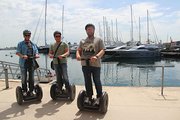
FAQs
FAQs
Here you can find quick answers to all of your questions. Linked, you’ll find the articles or the sections of the articles that can give you more detailed information.
-
Ruzafa is a neighbourhood in Valencia’s Eixample district. It is the hippest area of the city.
-
Ruzafa is a lively and popular area, known for its art galleries, American-style cafes, quirky bars, and artisanal businesses.
-
Ruzafa is in the western part of the Eixample, south of the city centre. It is delimited by Avenida de Peris i Valero to the south, Avenida del Regne de València to the east, and the train track to the west. If you want, you can check out our map of the neighbourhood.
-
Ruzafa is not known for its churches (that would be the Seu neighbourhood, in the Old Town), but you can still enjoy the Parroquia de San Valero y San Vicente Mártir.
If you want to find out more about this building, you can do so in the dedicated section of this article.
-
While Ruzafa doesn’t have as many museums as El Carmen, there are still interesting places you can visit. One is the Museo Taurino inside the city’s Plaza de Toros.
If you’re into contemporary art, you can visit the neighbourhood’s art galleries.
-
Although Ruzafa is more well-known for its vibrant community and lively streets, there is still plenty to see in the neighbourhood. Some unmissable sights are the Plaza de Toros, at the northern edge of the barrio, and the Mercado de Russafa.
But remember, the soul of Ruzafa is with its terrace bars, hipster bookstore cafes, and quirky art galleries. If you’d like to know more about the barrio’s sights, you can read the relevant sections of our article.
-
What’s for sure is that Thursday to Saturday is when the barrio is most alive. Then, depending on the kind of activity you’re interested in, there are different times to visit Russafa.
The morning is ideal for those that want to visit markets and cute cafes. Meanwhile, Ruzafa’s famous cocktail bars are best enjoyed in the evening and at night.
-
Basically anywhere in Ruzafa, the neighbourhood is known for its many bars and drinks venues. We particularly recommend some streets: Calle Cadiz, Calle Sueca, Calle Cuba, and Carrer del Literat Azorí.
If you’d like to know about some specific venues, check out the nightlife section of this article.
-
Absolutely. Valencia is an extremely bike-friendly city. On the official map, you’ll see that the bike path network covers the entire city. You can also cycle in pedestrian zones, as long as there is enough room for people to walk.
If you’d like to know more about traffic rules and norms in Valencia, you can check out our article about cycling in Valencia.
-
There are quite a few buses that circulate in the neighbourhood. In fact, buses are one of the best ways to get to Ruzafa. Lines 6, 7, 11, 15, 19, and 35 all pass by here.
For detailed information about this, you can read our article about buses in Valencia.
-
There are no underground metro stops in Ruzafa itself. The closest ones you’ll find are Xàtiva (lines 3, 5, and 9) and Colón (lines 3, 5, 7, and 9), which are both at the southern edge of the Old Town. These metro stops are all 10-15 minutes away from this barrio.
What you’ll find instead is (above-ground) tram stops.For detailed information about the metro system in Valencia, you can read our article about it.
-
Trams are a good way to get to Ruzafa. The network’s line 10 has a couple of stops at either side of the neighbourhood. They are Alacant and Russafa.
For detailed information about the trams in Valencia, you can read our article about it.
-
There are nine Valenbisi stations all over Ruzafa and many more in the surrounding neighbourhoods of the Old Town.
If you’d like to know more about Valenbisi, you can check out our article about it.
-
Yes, absolutely. In fact, this is one of the preferred ways to move around the neighbourhood.
Just remember that there is a no-park zone indicating the areas that are off-limits for your electric scooter. You will see it on your app’s map.If you want to know more about electric scooters in Valencia, check out our article about them. You’ll find step-by-step instructions and video guides.
More related activities...
You might also be interested in...

All you need to know for your first Fallas
A complete guide on everything you should know before visiting Valencia during Fallas. All the major events, the best time to come by, budget suggestions, and how to go about your accommodation. All the essentials for first-time visitors to the festival.

History of Fallas
Fallas is an incredibly rooted tradition in Valencia, but when did it become as we know it today? What are its origins? How has it changed over time?

All you need to know about Valencia
A complete guide on everything you should know before visiting Valencia. All the major attractions, the best times to come by, budget suggestions, transport, and our tips.

Despertà
A thundering, electrifying parade of popping firecrackers and upbeat marching band music. This is how Valencia wakes up during Fallas.

The metro and tram in Valencia
Valencia’s urban rail network counts a total of 146 stations, divided into ten active lines. With its total length of 162 km, it covers Valencia’s urban area thoroughly and it is a great way to move around the city.

Fallas frequent questions
What is Fallas exactly, why do people care about them so much, what are all of these events? All your doubts about Fallas cleared up.













